Sometimes we use one, not necessarily related, noun to describe another. For example, “That V8, two-seater, something or other, pulls like a freight train”. Or, “Any way you cut it, that 74 Mercury Grand Marquis is a boat“. And that boat reference turns up pretty often in automobile discussion circles. Well, it’s about to turn up again only this time, we’re serious, “That 1958 Whirlwind runabout is a nice boat“. And, it really is a boat and we’re going to review it right here on Barn Finds, a site dedicated, usually, to all things automotive. This Whirlwind runabout is located in Phillipsburg, New Jersey and is available here on eBay for a current bid of $510, twenty-four bids tendered so far.
The Whirlwind story is interesting, it gets its start at the end of World War II when Allied Aviation, a Dundalk, Maryland contracting firm known for building war effort, wooden navy gliders, is essentially out of business with the war’s conclusion. The CEO of the firm, along with several senior managers, decided to try their hand at boat building and they were ultimately successful securing a small contract with the U.S. Naval Academy. Ultimately, the owner of Allied Aviation decided to stay in the flying business so the boat business was spun off to the senior management, and Whirlwind was born. Operating from a new, rural setting in Cockeysville, Maryland, Whirlwind produced about 15K boat hulls between 1946 and 1962. Howard Johnson, (no, not the innkeeper/restauranteur) is the keeper of the Whirlwind history and a curator in his own right, and several years ago he wrote this detailed history of Whirlwind, hopefully, you’ll find it interesting.
This 14 footer is being sold as a result of a charitable donation that will benefit Boat Angel Outreach, a religious endeavor. The sale includes a trailer but the seller suggests that it is not road-worthy. The listing is a bit of a mind-run of information, seemingly influenced by a desire to ensure limited liability. The natural, unpainted, exposed woodwork looks to be in great shape – and that’s an accomplishment, wooden roads that see regular use, require a lot of annual sanding and varnishing. The effort is compounded that much more so if the boat is domiciled outdoors. The hull is showing no obvious sign of rotted wood though the painted portion is not too revealing. The same with topside, no indication of peeling, cracking, fading or any other shortcomings. Its Batmobile inspired, tall, wraparound windscreen, in concert with its narrow, five-foot beam, is a perfect representative of 1950’s small boat design.
At fourteen feet overall length, this is not even a medium-sized craft and it appears it could accommodate maybe four riders at best. The narrow beam and shallow freeboard of this Whirlwind would probably best suit it for calm water operation, perhaps a lake, as opposed to tidal water bodies. The interior is very spartan, as expected, so a basic runabout, as this boat is described, would seem to be its most appropriate use.
Included in the sale is a 3HP Mina Kota, electric trolling motor but it is inoperative. My question would be how big a motor will the transom support? I would think more than just 3 HP, that seems appropriate for a square back canoe, I imagine this Whirlwind can manage a bit more. Since Whirlwinds are pretty well documented, that type of information should be obtainable from various sources. You may even be able to contact HoJo and get some advice!
I came across this video of Mr. Johnson’s boat, “Sputnik”, filmed by a drone as it enjoys the waters of the Chesapeake Bay in and around beautiful St. Michaels, Maryland. This offered boat is not exactly in the same class as the one featured in the video but it does portray an idyllic, on the water setting. At only $510 and two days to go in the bidding, this historically significant runabout may be quite the buy, it would be a very relaxing way to enjoy narrow, inland waterways and lakes. It would be great to hear from Barn Finds auto enthusiasts that also have a boat jones going on – what boats do you own and how to you usually enjoy them?
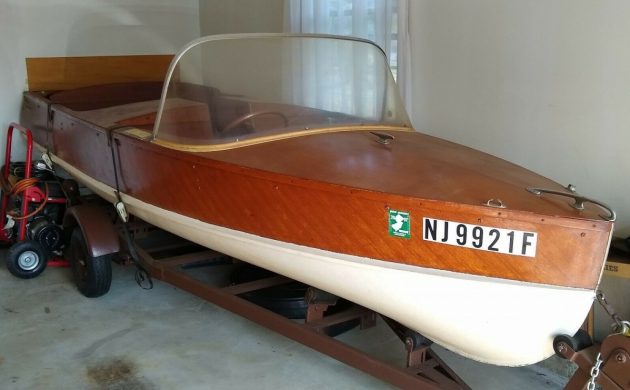
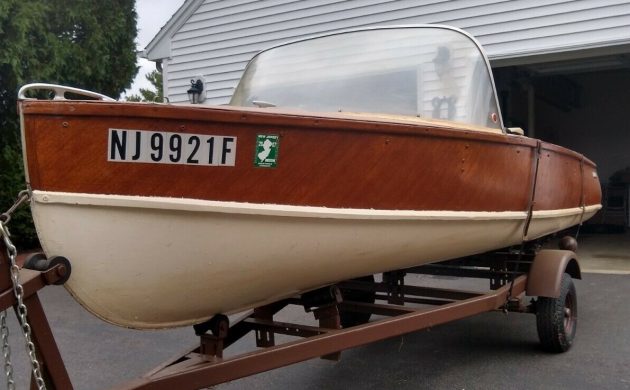
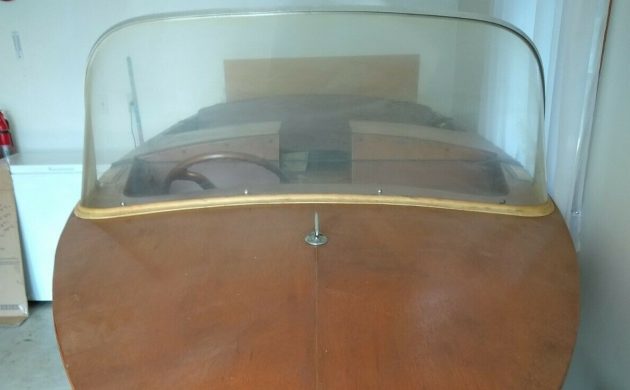
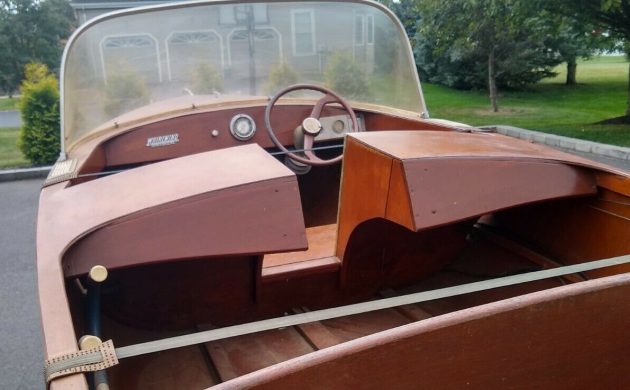

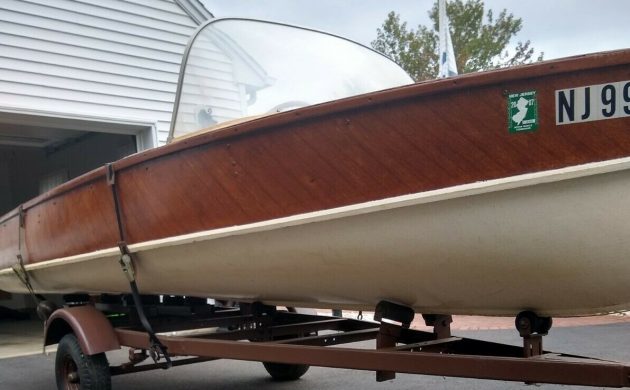

( crickets) Nobody wants these anymore, and that’s a shame. At one time, small boats like this were huge. Everybody knew someones old man building one in their garage. I think you could buy plans, or kits. Obviously, the trolling motor is horribly out of place, and these typically ran a 25 or 30 hp “Johnnie” or a “Rude”, or Scott-Atwater( remember them?) anything more would tear the transom off. From a time when this was good enough,,,
Yep, I have a 1.5 h.p. 1948 Scott-Atwater stored in my basement. This one happened to be sold by my dad’s Firestone Store, and is labled Firestone.
My father collected outboard motors, from 1900 to 1960 models. Johnson 40’s and 60’s were the workhorses of his collection but he had everything, at one time around 120 outboards. He had several models of Scott-Atwater as well. I’d think this fine boat would take up to a 40 hp engine without much issue but 25-30 would be plenty for sure. I’m tempted……
I had a 25 horse Johnson on mt Whirlwind and flipped in a heartbeat.
Agree with Howard, I own a 56 Feathercraft, aluminum boat of similar size, came with a 35 “Johnnie”. Transom is aluminum reinforced with wood.
I had a boat that looked similar to this one, built from a Popular Mechanics plan. It was a hydroplane and the transom supported a 40 hp outboard. Ancient history to me now, but seeing this boat brings back pleasant memories.
I bought one of these when I was 13 years old for $25.00.My dad and I refinished it.It had a 25 h.p. Johnson on it.I had it for a couple of years until I flipped it and my dad decided it might not be safe and sold it.
Hmm, after watching the video I want this little guy, but don’t even have a vehicle to haul it with or place to keep it.
They are really nostalgic, but require a huge amount of maintenance. Perfect for the guy that loves all of the work. I’ll stick with my cars.
An old man once told me, “Cars cost ten times more than motorcycles. Boats cost ten times more than cars. Airplanes cost ten times more than boats.” He went on, ” If it rusts, flies or floats, sooner than later it’s gonna give you trouble. “
I bought my first ‘real’ (at least to me) boat as a teenager in 1972, a 1957 14 ft Thompson wooden lapstrake runabout, with the ‘big twin’ 35 hp Evinrude outboard. I’ve been messing around with boats ever since. I used to see boats like this Whirlwind around all the time back then, puttering around on the lakes of upstate New York and on the Hudson River. Almost all of them have long since rotted away.
In the late 1950’s wooden boat construction still ruled. The first fiberglass boats were just beginning to come onto the scene, with mixed results. Boats have been built of wood for centuries. It was a well-known path at the time – well-known how to build them, and also well-known for the constant maintenance they needed. Wood is an unforgiving material when put into water. If you let up on maintenance even for a short while, it quickly rots and decomposes.
The Whirlwind was an attempt at ‘modernizing’ wooden boat construction. This one is made of cold-molded plywood. Unlike most boats at the time, which were built either of plank-on-frame construction using conventional solid wood planks, or plywood (either in sheets for flat surfaces, or cut into ‘planks’ for a lapstrake design), Whirlwind and a few other manufacturers played with cold-molded plywood.
A mold was generally used (similar to later fiberglass boats), but instead of laying up layers of glass cloth and resin, thin veneer sheets of wood were ‘molded’ in place and glued together. I don’t know what kind of glue Whirlwind used. Resorcinol was commonly used at the time, and worked pretty well if applied properly with pressure and enough time to bond. The synthetic polyester and epoxy resins were ‘new’ and not much was known about them.
The idea was to both simplify construction (to be able to build it more quickly and cheaply), to give the ability to curve the wood more easily into shapes planks and plywood didn’t like to go, and also to try and minimize maintenance. A cold-molded plywood boat came out with kind of a continuous single surface that was more resistant to leaks (at least early in its life and if it was kept in good condition). With no seams between planks or sheets, regular caulking wasn’t required like it was on other wood construction techniques.
Sometimes the finished boat had the bottom covered in a layer of fiberglass cloth and resin. This boat is a different color below the chine strip (the beige bottom). I can’t tell from the photos if it’s been fiberglassed on the bottom or it’s just bottom paint.
In the 1960’s and 1970’s when I was messing around with wooden boats, the cold-molded technique did seem to produce a lower-maintenance product than conventional wood construction. But one of the weaknesses was it was much more difficult to repair. If (or when…) the veneer layers started delaminating (as plywood used for boat construction inevitably does after a while), it’s much harder to repair a cold-molded boat that is essentially one continuous piece than removing a plank or sheet. I remember friends with cold-molded boats at the time basically throwing them away because of extensive delamination.
At the time the Whirlwinds were also more lake than river boats. Narrow beam, shallow draft, low freeboard, and light weight meant you wouldn’t want to take it out on anything other than a calm day. I would see them on the lakes in upstate New York much more often than the Hudson River. 15-30 hp outboards were what I recall seeing on them. I don’t think I remember ever seeing one with anything bigger than the 28 hp Johnson twin of the time. For such a light boat, with a light load (a couple of people), it was more than enough for a fun and fast (for the time) ride, zipping around a forested lake in the Catskills or Adirondack mountains.
Any 1950’s wooden boat remaining today is a collector’s item for display or only very occasional use. If anyone had thoughts of actually using this boat I would suggest going over every single square inch of it to look for any delamination.
Ironically, an updated version of this kind of ‘cold molded’ construction has come back for some custom-built boats. Now it’s called ‘composite’. It’s a similar technique, though now planks and regular (marine-grade) plywood are also used as well as veneers, and of course nowadays it’s all synthetic resin, usually epoxy, that’s used to thoroughly saturate all the wood and surfaces. It’s not really any cheaper than fiberglass, but does allow for building one-off boats (female molds are now rarely used).
They are beauties, and have a soul and character that no fiberglass boat can ever match.
Great contribution AnalogMan!
Thx,
JO
Thanks!
Almost bought a ’57 Carver Captain from my neighbor next door. Looked really nice for the shape it was in with no
real rot anywhere. I was just about to pull the trigger and buy it when Dad called to see what we were up to. When
I told him about the boat, he almost blew a gasket! “Don’t you know what
boat stands for?” When I said “No”, he
explained it to me in language that even
I could understand. “Boat” he said,
“Stands for Bust out another thousand.”
It’s been almost 40 years since he said
that and to this day that’s why I never
bought one.
Excellent post @AnalogMan. I have a Wagemaker of similar construction that now needs re-restoring. A prior owner did some great work on her but did adequately address some hull rot and as the saying goes “it hasn’t gotten better with time”. Elegant little crafts in competition with cars for restoration time.
Scott Attwater. They were green and yellow and their claim to fame was a automatic bugle pump. They never caught on in the Puget sound area. I never saw one run. Later…………………………………JIMMY
I own a 1956 17 foot whirlwind. Have had it for 35 years. They are not cold molded. Select mahogany veneers are laid alternately on a mold. Heat activated glue and Staples are applied, then it is bagged, placed in an oven. Vacuum pressure is put on the bag and they are baked at 350 for over an hour activating the glue. They do not delaminate. Very good strong boats.
SOLD for $810.